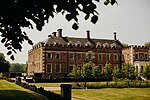Dorset Cursus
Archaeological sites in DorsetBuildings and structures in DorsetHistory of DorsetLinear earthworksScheduled monuments in Dorset ... and 2 more
Stone Age sites in EnglandTourist attractions in Dorset

The Dorset Cursus is a Neolithic cursus monument that spans across 10 km (6¼ miles) of the chalk downland of Cranborne Chase in east Dorset, United Kingdom. Its extreme length makes it a notable example of this class of linear earthwork; it is better interpreted as a pair of same-length cursus constructed end to end, with the more southerly cursus (the Gussage Cursus) pre-dating the northerly one (the Pentridge Cursus).
Excerpt from the Wikipedia article Dorset Cursus (License: CC BY-SA 3.0, Authors, Images).Dorset Cursus
B3081,
Geographical coordinates (GPS) Address Nearby Places Show on map
Geographical coordinates (GPS)
| Latitude | Longitude |
|---|---|
| N 50.9434 ° | E -1.9752 ° |
Address
B3081
BH21 5PN , Wimborne St. Giles
England, United Kingdom
Open on Google Maps









